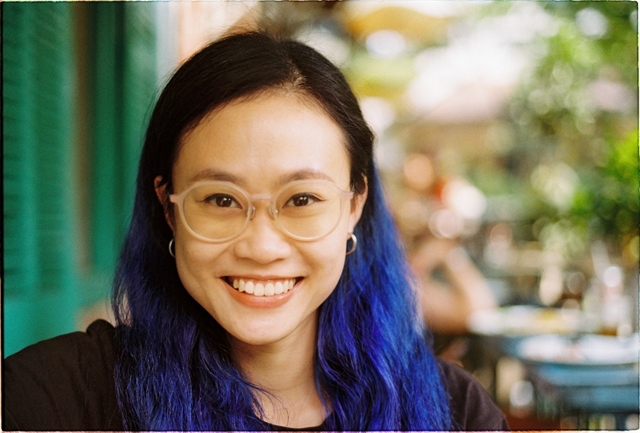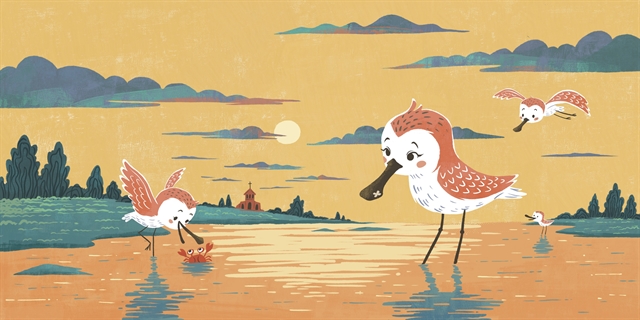 Life & Style
Life & Style

Nguyễn Vũ Xuân Lan went to London last month to attend the exhibition The Return of the Spoon-Billed Sandpiper. The exhibition is fruit of a workshop in Hà Nội for Vietnamese artists, held by British and Vietnamese partners. Việt Nam News reporter Nguyễn Bình interviews Lan about the workshop and her trip to London.

|
| Nguyễn Vũ Xuân Lan. Photos courtesy of Xuân Lan |
Nguyễn Vũ Xuân Lan went to London last month to attend the exhibition The Return of the Spoon-Billed Sandpiper. The exhibition is fruit of a workshop in Hà Nội for Vietnamese artists, held by British and Vietnamese partners.
Việt Nam News reporter Nguyễn Bình interviews Lan about the workshop and her trip to London.
Could you introduce yourself? How was your journey to London?
I’m Xuân Lan, a freelance illustrator based in Hà Nội. I’ve been working in illustration for several years, after quitting previous jobs as an English lecturer at my college and a manager in a company. You can see most of my works at my facebook page X.Lan.
There’s a common misunderstanding about my trip to London. There was no winner in the workshop. I was just chosen to attend the exhibition in London on behalf of my classmates.
When our graduation artworks were on display, all of us were supposed to travel there. However, due to a limited budget, only one of us could be sponsored.
I guess there are some reasons I was chosen as the representative for my class. I was the oldest, and probably have more working experience than other members in the workshop, and I can speak English quite fluently.
At this moment, we still don’t know who will be chosen as the one to illustrate the complete book to be published this year. Nhã Nam publisher and our instructors still have to make that decision.
What did you gain from the workshop with UK artists Jan Fearnley and Jane Buckley?
We all learned a lot from our two instructors, especially young artists just starting their illustration careers.
Even with several years of experience, I still found new approaches to making books for children when listening to what Jan and Jane shared, from drawing and story-telling skills like character design and emotion expression, to more technical things such as printing and layout.
They really made an effort to spend time with each member of the class, paid attention to each of our struggles, offered advice and, most important of all, encouraged us to follow and improve our own drawing styles.
What I appreciated most was the time I had with my classmates. You may know this or not, but illustrators are quite often introverts.
The nature of our work is individual, so we don’t have much chance to hang out with fellow artists.
This workshop is a perfect opportunity for us to meet up, work together and learn from one another. It was refreshing to be able to communicate with “our kind”.

|
| One of Xuân Lan's illustrations after she attended the workshop in Hà Nội. |
Did you know writer Trang Nguyễn before the workshop? What was the biggest difficulty for you and other workshop participants in illustrating her story?
We knew Trang from before as she had published two books on rescuing bear and elephant, with phenomenal illustrations by Jeet Dzung. Some of us had even worked with her.
Regarding the story, wildlife conservation is not a common theme for children’s books. Therefore, it’s a challenge as well as a chance for us to learn about bird migration and relevant issues.
We had quite a lot of difficulties through the process, most of which concerned how we should visualize and stylise the characters and other details.
As illustrators for children, we tend to stylize things and prioritise the aesthetic aspects of the illustrations.
However, when the story has a certain educational purpose, some details should be kept relatively realistic and recognisable, especially the spoon-billed sandpipers and other specific birds.
Most of us struggled for a while before we could find our own way of depicting the characters and environment.
For me, my strong point is drawing human characters. Illustrating animals and birds is quite challenging for me as I have to look for other ways to express their emotion.
Which illustrations by others at the workshop do you like?
I was amazed that each of the participants had their unique drawing style. The final illustrations for the exhibition are our best takes, so it’s difficult to choose just one that I like better than others.
The exhibition is arranged in a way that allows audience to actually read the whole story, but each page is the work of a different artist.
If you follow the story, you will find yourself surprised every time you move on to the next page.
It is still that spoon-billed sandpiper on her journey, but with radically different design. Our instructors, Buckley and Fearnley encouraged us to push our personal style in these artworks without worrying too much about the final book (because that will come much later). And that worked.
You went to London to attend the exhibition The Return of the Spoon-Billed Sandpiper opening ceremony. How did you feel? Could you talk about the trip?
I was super proud of my mates, and of myself too. Looking at our drawings printed out in large size and displayed at a splendid venue, I felt that the hard times studying and struggling with deadlines were all worth it.
The trip to London was very unexpected for me, so I was excited and nervous at the same time. It was not my first time travelling abroad, but going to a new place is always an eye-opening experience.
I spent most of my time there at museums and bookstores. I also had chance to meet Jane Buckley again, at Simon & Schuster publishers, and had a nice talk after two months since our last class.
Overall, I couldn’t be more grateful to Nhã Nam and British Council, for both the trip and the workshop.
You were not trained in the arts, and used to be an English lecturer at the University of Languages and International Studies at Việt Nam National University. What are the advantages and disadvantages for you to pursue the arts?
Working as a self-taught illustrator, I have a number of disadvantages. The most prominent one is the lack of foundational skills. I had to spend lots of time learning from any source I can find, from my seniors and my peers.
I did improve, but at a very slow rate, which sometimes was frustrating. Therefore, I would always sign up for drawing workshops or courses whenever I had the chance.
On the other hand, the time I spent at university, both as a student and a lecturer, did offer me an important skill set. It’s logical thinking and writing skill, which contributes remarkably for my story-telling in art.
Also, working with students trained my teamwork and presentation skills, which later transferred to how well I communicate with fellow artists and clients. — VNS




